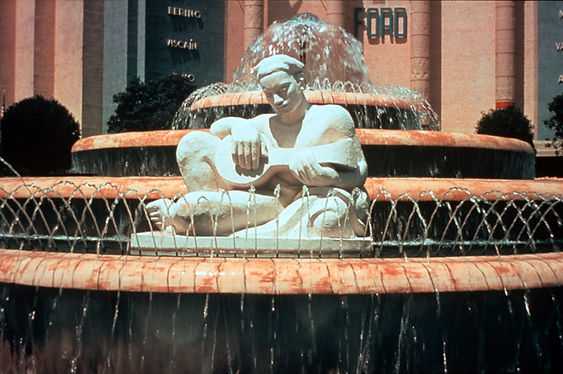The Pacific Unity Sculptures

Note: Two of the sculptures described on this site were recently moved to storage due to the ongoing renovation of Building One. The four that remain on view as of March 2022 are (from left to right):
"Spirit of India," (Jacques Schnier), "Islands of the Pacific" (Adaline Kent), "Islands of the Pacific" (Adaline Kent), "Spirit of India," (Jacques Schnier)
These four sculptures are on view at all times in front of Building One, the large building at the entrance to Treasure Island which houses the museum.
Use the buttons above to learn more.

Treasure Island was constructed to be the site of the Golden Gate International Exposition, which took place in 1939 and 1940. The theme of the fair, Pacific Unity, found its most eloquent expression in the Court of Pacifica, of which Timothy Pflueger was the design chief.
Presiding over the court was sculptor Ralph Stackpole's eighty-foot "Pacifica," the fair's mythical goddess of the western ocean. Arranged around the circular, three-tiered Fountain of Western Waters at the center of the court were twenty oversized Pacific Unity sculptures representing the peoples of the Pacific.
Twelve smaller sculptures, twice lifesize, were arranged on the tiers of the Fountain of Western Waters. On the plaza surrounding the fountain were eight larger sculptures. They represented major geographical areas of the Pacific: the Americas, the South Pacific, and Asia. The larger figures were posed as for formal portraits – poised and dignified. The smaller, more dynamic sculptures were captured in spontaneous action: dancing and making music, working, sleeping.

The Pacific Unity sculptures were characteristic of the 1930’s in their themes, which pay tribute to the common man; their proportions, which are heroic; and their stripped-down, streamlined look. They lack the conventional embellishments that often characterized American monumental sculpture, especially sculpture for world's fairs: classical proportions, flattering postures, flowing robes, wings, and other props derived from classical mythology.
The sculptures are weighty, compressed, and full of energy. The artists created an aspect of refined primitivism. If you don't look too closely, you might think that the sculptures had just been unearthed from some archaeological dig. They were admired by public and art critics alike: Alfred Frankenstein, venerable art critic of the San Francisco Chronicle, considered them to be the finest sculpture made for the fair.
Sculpture for world's fairs is usually made of plaster, which will disintegrate within a few years. But the Pacific Unity sculptures, made of cast stone, were meant to last.

Ten of the sculptures survive in storage, and four have disappeared. During the 1980s and 1990s, the Treasure Island Museum Association (now the Treasure Island Museum) raised funds to have the sculptures repaired, restored, and placed on public display. Plans to restore and display all of the sculptures were interrupted by the closure of Naval Station Treasure Island in 1997, but are now anticipated as part of the Treasure Island Arts Master Plan.
Six of the sculptures have been restored and have been on display, flanking the main entrance doors to Building One. The six sculptures were the work of three different artists, and were displayed in pairs on opposite sides of the doors. They were, from left to right:
-
"Flutist," from “Chinese Musicians” group (Helen Phillips)
-
"Islands of the Pacific" (Adaline Kent)
-
"Tree of Life," representing India (Jacques Schnier)
-
"Tree of Life," representing India (Jacques Schnier)
-
"Islands of the Pacific" (Adaline Kent)
-
"Blowing a Horn," from “Chinese Musicians” group (Helen Phillps)
Online statues content designed by Urso Chappell
